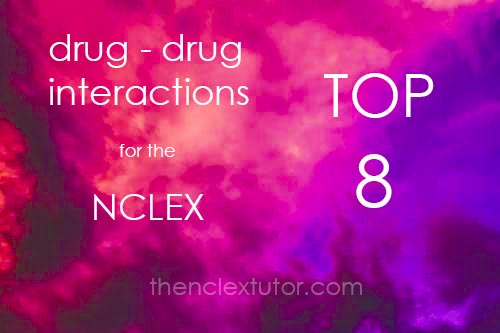These are the top 8 common drug-drug interactions every nursing student taking the NCLEX should know.

1) Erectile dysfunction drugs and Nitrates
All the erectile dysfunction drugs end in FIL, like sildenFIL. Nitrates are the anti-anginal meds that treat chest pain. Taking these two meds together can cause severe hypotension. It’s not hard to imagine the older man who can’t get an erection, but just popped a pill because he knows he’s going to get lucky tonight. But he also has cardiovascular disease and carries around his nitro in case he gets some chest pain.
2) Potassium Chloride and Spironolactone
Spironolactone is a potassium-sparing diuretic, which means the body holds on to potassium. If a patient takes extra potassium pills they can get severe hyperkalemia and get a dysrhythmia.
3) NSAIDS and Warfarin
NSAIDS increase the risk of GI bleeding. Warfarin is an anti-coagulant that increases the risk of bleeding also. Together, they REALLY increase the risk of bleeding. This is also not hard to imagine the client that takes warfarin because of the risk of blood clots. Then she has some arthritis and takes some OTC NSAIDS for the pain. Bad move.
4) Lithium and Diuretics
Lithium is for bipolar and is a salt. Diuretics get rid of fluids and can also get rid of sodium (which is a salt). The lithium level can become toxic causing symptoms of GI upset and tremors.
5) Clonidine and Propranolol
Both meds treat hypertension. When clonidine is suddenly stopped, the patient can get rebound hypertension. This puts the patient at risk of a hemorrhagic stroke.
6) Antibiotics and Oral Contraceptives
Taking these together increases the risk slightly for pregnancy. Tell client to use another form of birth control when on antibiotics.
7) Monamine oxidase inhibitors (MAOIs) and other Anti-depressants like SSRIs
Stop MAOIs for at least 2 weeks before taking other antidepressants. It can cause serotonin syndrome which has UPPER-type symptoms (agitation, muscle twitching, fever, seizures)
8) Digoxin and Quinidine
Digoxin is a heart med that decreases the heart rate. Quinidine is an anti-arrhythmic. Taking these together can cause dig toxicity. Dig toxicity can have early symptoms of GI upset, seeing halos around lights and then death.
Are there any drug-drug interactions that you know about? Post it below!